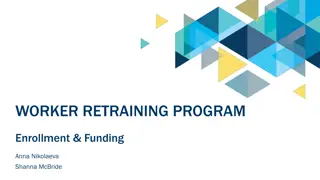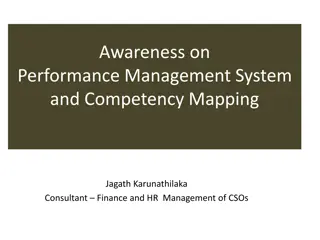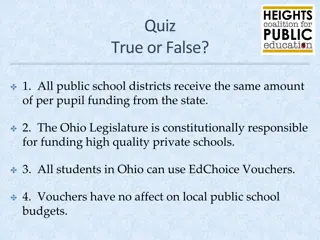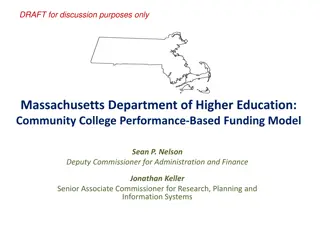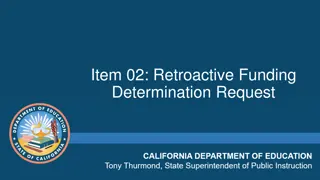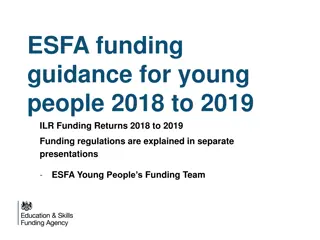PERFORMANCE- BASED FUNDING
A presentation on performance-based funding in higher education, discussing funding formulas, states implementing performance indicators, and post-graduation employment metrics.
Download Presentation

Please find below an Image/Link to download the presentation.
The content on the website is provided AS IS for your information and personal use only. It may not be sold, licensed, or shared on other websites without obtaining consent from the author.If you encounter any issues during the download, it is possible that the publisher has removed the file from their server.
You are allowed to download the files provided on this website for personal or commercial use, subject to the condition that they are used lawfully. All files are the property of their respective owners.
The content on the website is provided AS IS for your information and personal use only. It may not be sold, licensed, or shared on other websites without obtaining consent from the author.
E N D
Presentation Transcript
PERFORMANCE- BASED FUNDING P R E S E N T A T I O N T O I A L W O R K S H O P J U N E 2 0 1 7 J O E G L O V E R , U N I V E R S I T Y O F F L O R I D A
Every man has his own destiny: the only imperative is to follow it, to accept it, no matter where it leads him. Henry Miller
Thirty-two statesArizona, Arkansas, Colorado, Florida, Illinois, Indiana, Kansas, Louisiana, Maine, Massachusetts, Michigan, Minnesota, Mississippi, Missouri, Montana, New Mexico, New York, Nevada, North Carolina, North Dakota, Ohio, Oklahoma, Oregon, Pennsylvania, South Dakota, Tennessee, Texas, Utah, Virginia, Washington, Wisconsin, and Wyoming have a funding formula or policy in place to allocate a portion of funding based on performance indicators such as course completion, time to degree, transfer rates, the number of degrees awarded, or the number of low-income and minority graduates. Five states Connecticut, Georgia, Iowa, South Dakota, and Vermont are currently transitioning to some type of performance funding, meaning the Legislature or governing board has approved a performance funding program and the details are currently being worked out
1. PERCENT OF BACHELORS GRADUATES ENROLLED OR EMPLOYED ($25K+) IN U.S ONE YEAR AFTER GRADUATION This metric is based on the percentage of a graduating class of bachelor s degree recipients who are enrolled or employed (earning at least $25,000) somewhere in the United States. Students who do not have valid social security numbers and are not found enrolled are excluded. Note: This data now non-Florida employment data.
2. MEDIAN WAGES OF BACHELORS GRADUATES EMPLOYED FULL-TIME IN FL ONE YEAR AFTER GRADUATION This metric is based on annualized Unemployment Insurance (UI) wage data from the fourth fiscal quarter after graduation for bachelor s recipients. UI wage data does not include individuals who are self-employed, employed out of state, employed by the military or federal government, those without a valid social security number, or making less than minimum wage.
3. COST PER BACHELORS DEGREE Recently changed by BOG to mean cost to the student
4. SIX YEAR FTIC GRADUATION RATE This metric is based on the percentage of first-time-in-college (FTIC) students who started in the Fall (or summer continuing to Fall) term and had graduated from the same institution within six years.
5. ACADEMIC PROGRESS RATE This metric is based on the percentage of first-time-in-college (FTIC) students who started in the Fall (or summer continuing to Fall) term and were enrolled full-time in their first semester and were still enrolled in the same institution during the Fall term following their first year with had a grade point average (GPA) of at least 2.0 at the end of their first year (Fall, Spring, Summer).
6. BACHELORS DEGREES WITHIN PROGRAMS OF STRATEGIC EMPHASIS This metric is based on the number of baccalaureate degrees awarded within the programs designated by the Board of Governors as Programs of Strategic Emphasis . A student who has multiple majors in the subset of targeted Classification of Instruction Program codes will be counted twice (i.e., double- majors are included).
7. UNIVERSITY ACCESS RATE This metric is based the number of undergraduates, enrolled during the fall term, who received a Pell-grant during the fall term. Unclassified students, who are not eligible for Pell-grants, were excluded from this metric
8. GRADUATE DEGREES WITHIN PROGRAMS OF STRATEGIC EMPHASIS This metric is based on the number of graduate degrees awarded within the programs designated by the Board of Governors as Programs of Strategic Emphasis . A student who has multiple majors in the subset of targeted Classification of Instruction Program codes will be counted twice (i.e., double- majors are included).
9. NUMBER OF FACULTY AWARDS Based on the number of faculty awards in the arts, humanities, science, engineering and health fields as reported in the annual Top American Research Universities report. Twenty three of the most prominent awards are considered, including: Getty Scholars in Residence, Guggenheim Fellows, Howard Hughes Medical Institute Investigators, MacArthur Foundation Fellows, National Endowment for the Humanities (NEH) Fellows, National Medal of Science and National Medal of Technology, Robert Wood Johnson Policy Fellows, Sloan Research Fellows, Woodrow Wilson Fellows, to name a few awards. Source: Center for Measuring University Performance, Annual Report of the Top American Research Universities (TARU).
10. LICENSES AND OPTIONS New metric 10 definition UF has ranked in top ten nationally for years In fiscal year 2015 (most recent data), UF ranked third in the nation for licenses and options executed(261) (behind the Minnesota system (268) and the University of Washington (337)).
1.Each Board of Trustees should choose three metrics from the attached list of metrics. One of the three metrics can be the current metric. If there is not a metric on this list that the university has included in its institutional strategic plan then contact Board staff to discuss. The three metrics should be prioritized in order of preference. 2.The Board of Trustees should propose benchmarks for excellence, on a scale of 1-10, for each of the three metrics. The excellence benchmarks should be established so that in the first year of implementation, the university will receive no more than seven (7) points. 3.The Board of Trustees should propose benchmarks for improvement, on a scale of 1-10, for each of the three metrics.
1. National Rankings for Universities 2. Freshman in Top 10% of Graduating High School Class 3. Professional Licensure & Certification Exam Pass Rates Above Benchmarks 4. Percent of SUS courses bearing a high-quality rating in the Florida Virtual Campus online catalog 5. Average Time to Degree 6. Four-Year Graduation Rates 7. Six-Year Graduation Rates 8. Percent of Bachelor s Degrees without Excess Hours 9. Bachelor s Degrees Awarded Annually 10. Graduate Degrees Awarded Annually
1. Bachelors Degrees Awarded to African-American & Hispanic Students 2. Number of Adult Undergraduates Enrolled 3. Percent of Undergraduate FTE in Online Courses 4. Number of Institutions with at least 30% of Fall Undergraduates Receiving a Pell Grant 5. Academic Progress Rate 6. Bachelor s Degrees in Programs of Strategic Emphasis 7. Bachelor s Degrees in STEM & Health 8. Graduate Degrees in Programs of Strategic Emphasis 9. Graduate Degrees in STEM & Health 10. Faculty Membership in National Academies
1. Faculty Awards 2. Percent of Undergraduate Seniors Assisting in Faculty Research or Percent of Undergraduates Engaged in Research 3. Total R&D Expenditures 4. Percent of R&D Expenditures funded from External Sources 5. Number of Patents Awarded Annually 6. Number of Licenses and Options Executed Annually 7. Number of Start-Up Companies Created 8. Number of Universities with the Carnegie Foundation s Community Engagement Classification 9. Percentage of Baccalaureate Graduates Continuing Education or Employed
ALBERT EINSTEIN Many of the things you can count, don't count. Many of the things you can't count really count.



